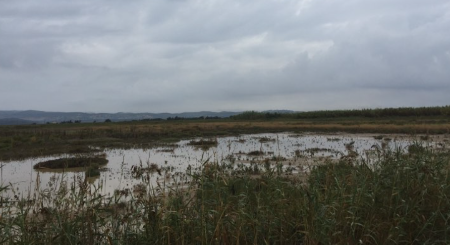Soil salinity corresponds to the accumulation of solutes in the soil, like sodium (Na+). This process is a major issue for agriculture and ecosystem processes of natural sites, such as Mediterranean salt marshes.
 © Photo : Victor Berteloot
© Photo : Victor Berteloot
In these environments, soil salinization, associated with groundwater salinity, is linked to the dynamics of water transfers in the soil. Upward flows, linked to hydrological processes such as capillary rise, lead to an accumulation of solutes in the root horizon. Inversely, downward flows, linked to infiltration and percolation processes, allow a leaching of solutes from the soil and a reconstitution of the water stock, thus decreasing the concentration of solutes in the soil solution.
The fact that the specific and functional composition of plant communities is largely modified by soil salinity conditions, and in turn have an effect on these water transfers in the soil is the main hypothesis.
The chosen study site, the Castelou site (Narbonne, France) , is an old vineyard that has become a salt marsh and is managed by winter flooding.
The strategy implemented to describe the interactions is divided into 3 axes of work :
-
a characterization of the hydrodynamic and chemical properties of the soil and the saturated zone, coupled with a monitoring of the soil water content,
-
an analysis of the specific and functional composition of the plant communities according to the salinity and management gradient highlighted in axis 1,
-
the calculation of water and solute fluxes in the soil using a physics-based hydrological model and the proposal of a conceptual model of water-soil-plant interactions in the context of soil salinity.
Key words: Soil Salinity ; Salt marsh ; Mediterranean basin ; Water-soil-plant interactions ; Water and solute transport in soils ; Functional traits.






